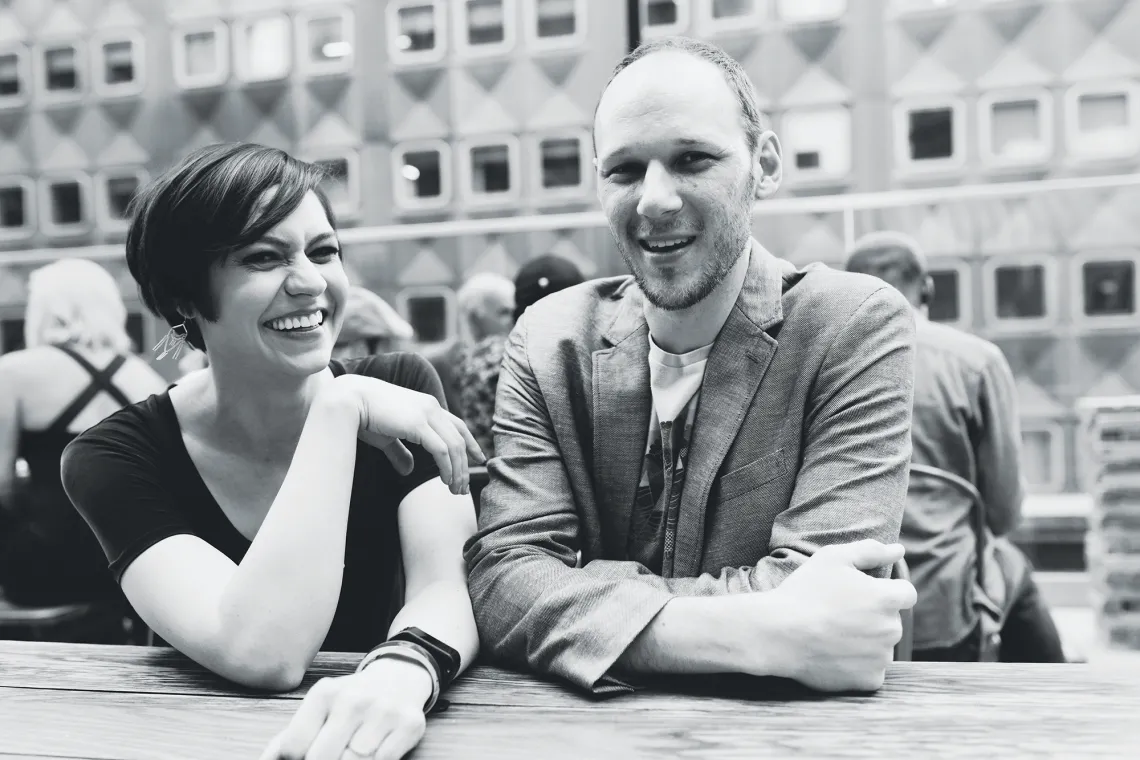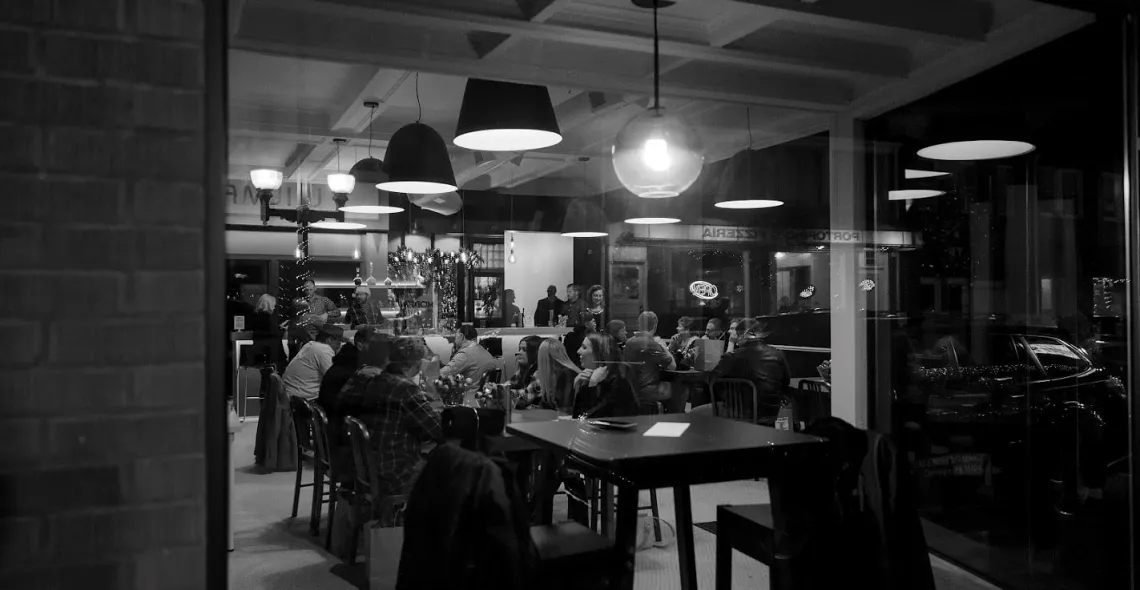Finding a Nerdy Niche in Business
Alumni donor reinvents craft spirit creations

Ryan Kanto ’07 and his wife, Sarah, are dedicated believers in research and the scientific method.
“That’s kind of how we look at life,” says Kanto, co-founder of Quantum Spirits in Carnegie, Pennsylvania.
In their new business, the Kantos are helping drive the future of craft distilling by incorporating science and engineering principles into every aspect of production.
In their giving to the University of Arizona’s College of Engineering, they’re determined not only to move the needle but also to measure that movement so that students will gain the most benefit possible.

Quantum Spirits’ tasting room in Carnegie, Pennsylvania / Dustin Holbrook photo
A Changemaking Couple
“You know, it’s cool to be a nerd now,” Kanto says. “In pop culture, there’s a pervasive influence of engineering, science and science fiction.”
Kanto is a UA chemical engineering and engineering management graduate. He and Sarah set out to use science and technology to reinvent the way craft spirits are made. They officially opened Quantum Spirits on St. Patrick’s Day.
With the help of a physical chemist, Kanto monitors dozens of data points for each batch of vodka and gin produced on-site at Quantum Spirits. They use the data to control quality and discover ways to modify their results, such as changing the temperature at certain points in the process to affect the flavor profile.
Their approach is the basis for Quantum Spirits’ branding and marketing efforts, which are directed toward customers who embrace their inner nerd. Fans can get in on the science, affecting the taste of future batches by taking part in tasting panels.
“It’s exciting to see people who appreciate the scientific aspects of what goes into their product. We’ve had a lot of people come in and say, ‘I feel comfortable,’ or ‘This is my place,’” Kanto says.
Respect for local ingredients and history is another value customers appreciate, Kanto says. He distills from rye because it’s a local heritage grain. “A lot of American distilling owes its roots to this region of southwestern Pennsylvania. Before Prohibition, this part of the country was the distilling capital of the U.S.,” Kanto says.
“Respect the past. Drink to the future.” Quantum Sprits’ tagline shows appreciation for their community and ambition to influence craft distilling’s future. The Kantos are expanding Quantum Spirits’ product line to include aged spirits, and they recently barreled the company’s first whiskey.
“Application of science and engineering to aging whiskey is something that got us excited about founding the company to begin with,” Kanto says.
Making UA Engineering an Epicenter of Active Learning
Kanto graduated from the UA with a taste for how collaborative learning changes the classroom experience. His adviser, University Distinguished Professor of Chemical and Environmental Engineering Paul Blowers, was on a journey to try different teaching techniques. Today, Blowers is recognized as one of the UA’s collaborative teaching experts.

“He made a large impact in the way I view teaching and engineering training,” Kanto says.
In a collaborative environment, students take an active role in the learning process. For example, instead of listening to a lecture, they might explain concepts to their peers and solve problems in small groups. Expanding collaborative teaching is a high priority for the College of Engineering and the university.
“It’s not that we as instructors make the classes easier, but we remove many of the barriers that exist between freshman year and graduation,” Blowers says. “We help students to have a growth mindset, to have a peer network for helping each other, and to change the way they study.”
Ryan Kanto’s sister, Kara, also experienced this shift in teaching. Kara Kanto has earned two bachelor’s degrees from the UA: She completed a graphic design degree in 2010, then returned to earn a chemical engineering degree in 2017.
“I got to hear her perspective on the next version of these collaborative training classes,” Ryan Kanto says. “It was really cool to hear about how they’ve evolved and how successful they were in helping her to understand.”
Kanto and his wife were so inspired by the possibilities that they made a gift to help change the fundamental way engineering is taught at the UA. Their gift will support collaborative teaching for a five-year period. The gift includes funding faculty training, remodeling classrooms, rigorously tracking and evaluating teaching methods, and publishing the findings.
The College of Engineering has already started tracking retention rates for chemical engineering majors who take active learning classes, and their research shows improved retention. The Kantos and the college’s leaders want to build on this initial success by offering more of these classes and by identifying and implementing the specific techniques most helpful to students.
They believe this approach will give more credence to collaborative teaching and encourage other disciplines and universities to implement active learning techniques.
Within the college, the Kantos’ gift is intended to have long-term impact on student success and retention, including higher retention for female students and those from diverse backgrounds.
Former College of Engineering Dean Jeff Goldberg, now the UA’s acting provost, says collaborative classes are especially helpful to freshmen and sophomores.

“Our curriculum builds, so it’s absolutely critical that students get a strong foundation. Training our faculty gives our students the best possible teaching so they can be successful at learning, and that helps retention,” he says.
Private funding is essential for that training, Goldberg adds. “We really like to invest in faculty development, and there’s just not a lot of money available from our normal budget to do those kinds of things.”
The college has tentatively identified 12 first- and second-year courses as targets for this initiative. Each will be divided into two sections, with one taught in the traditional manner as a control group.
Both sections of each course will use the same materials — textbooks, quizzes and tests. Only the delivery mechanisms will vary. Regardless of the teaching method used, all students will benefit from smaller class sizes and the resulting increased attention from the instructor.
Although earning an engineering degree is hard work, Kanto says, it shouldn’t be something students suffer through.
“Finding a way to align the experience with the individual and the way they learn best, as well as something that makes them a better technical professional, is great,” Kanto says.
“We see a lot of opportunity, based on the work Dr. Blowers and others have done, to do something meaningful that moves the needle. That resonates with Sarah and me.”
Blowers is excited that the Kantos’ support will expand and enhance the practices he’s developed. Engineering lecturer Kasi Kiehlbaugh will co-lead the project with him.
“We cannot wait to see how this donation helps us help even more students succeed,” Blowers says.
Ready to Geek Out? A Chemistry Lesson from Ryan Kanto
What is the first step in making spirits?
We cook rye to make the starches water soluble. Enzymes that are naturally in the rye malt break down the sugars. We add yeast to it, and it eats the sugars. One of the byproducts is ethanol.
What is the transitional product?
What we basically did there is make a beer. It’s not necessarily beer you would drink, but there’s alcohol in it, and there’s a lot of really good flavors. It’s called a “wash.” It has 8 to 10 percent alcohol after five to seven days.

What happens once you get a “wash?”
We put the wash in a distillation apparatus to turn it into something much more pure. So we boil off the alcohol. The alcohol boils at a lower temperature than water. Because they have different boiling temperatures, you can use a distillation column to concentrate that alcohol.
What makes a good flavor or a bad flavor?
As the vapor goes up, it gets more concentrated. When it gets to the top, it may be 60 to 80 percent alcohol. We run this process and concentrate our alcohol, and that’s what separates the good flavors from the bad flavors.
How does it turn into vodka?
From there, we proof it down. For vodka, we take it up to 95 percent alcohol to remove the impurities, then dilute it and filter the product before we bottle it at 40 percent alcohol.
What about gin?
Gin is similar, except when we’re distilling, we add botanicals. Juniper berries are the big one, but we also add coriander or different types of herbs, spice or citrus, depending on what we’re trying to achieve.
What makes your liquor unique?
One of the things we do that’s a little bit unique is vacuum distillation. Normally, we have to heat it to around 190 degrees, and some of the delicate organics get broken down. Think about a fresh sliced orange versus orange that’s been cooked. It’s a lot brighter when it’s fresh cut. The same sort of thing happens with distillation.
When you reduce the pressure, you also reduce the temperature at which it will boil. Imagine all the little molecules in the air pushing down on the surface of the liquid. If you remove some of that pressure, you’re not exerting as much force on the surface of the liquid.
More of them are likely to pop off and turn into vapor than they are to stay in the liquid. With vacuum distillation, we can lower the temperature by 50 degrees or more, so we’re able to extract out these really delicate organic compounds without potentially destroying them or altering them.
